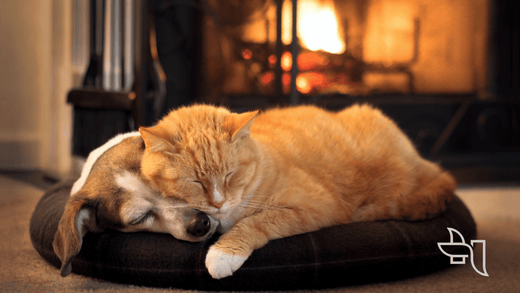
Winter Allergies in Pets: Tips for Reducing Indoor Allergens
As the long Minnesota winter quickly approaches, we all start to seal up our homes to keep the frigid air out, but that cozy indoor warmth can lead to an increase in allergy symptoms for us humans and our furry companions. With the furnace running seemingly non-stop, the air dries out and allergens (like dust mites, mold spores, and pet dander) start to build up, making your pet sneeze, feel itchy and just be uncomfortable.
Why Dry Air Aggravates Pet Allergies
When humidity levels drop, the air in your home dries out, causing irritation to your pets’ skin. Just like humans, our pets rely on the moisture in the air to keep their skin hydrated. Closed windows and doors trap allergens like dust mites and mold spores indoors, making them more concentrated in the dry air.
Common Indoor Allergens and Why They Flare Up in Winter
- Dust Mites: Dust mites thrive in household dust, and since dust tends to build up throughout the winter, their numbers increase.
- Pet Dander: With the furnace running more often, the dry air can cause pets to shed more. The shedding leads to higher levels of pet dander throughout the home, causing allergy symptoms to flare in allergic pets.
- Mold Spores: Mold can lurk in different areas like bathrooms, basements and sometimes even on indoor plants. With windows and doors closed tight, mold spores can’t escape and become more concentrated in the air, which can trigger allergies and respiratory issues for sensitive pets.
Dust Mites: What They Are and Why They Matter
House dust mites (Dermataphagoides species) are common in the environment and feed on human and animal dander, skin scales and hair. They thrive in humidity of 50–70% and are commonly found in beds, mattresses, carpets, sofas and pet bedding.
Dust mites are around year-round, but they worsen during the winter while we stay inside more and open our doors and windows less. Total elimination is impossible, but there are ways to keep them under control so it’s easier to manage allergy symptoms. Ideally, the entire household is incorporated in an environmental control program as outlined below.
Simple Tips to Help Your Pet Breathe Easy
There are some steps you can take to manage your pet’s indoor allergies to help make winter manageable for both of you:
- Run a Humidifier: Adding moisture to the air with a humidifier helps to combat dryness in the air. Aim for humidity levels between 40-50% to keep your pet’s skin hydrated and reduce allergy symptoms. A humidifier can make a huge difference in your dog or cat’s comfort, helping to prevent itchy skin and irritation.
- Keep Bedding and Living Areas Clean: Dander and dust mites can accumulate in furniture and bedding. Pet sleeping areas should be maintained according to the following guidelines:
- Wash bedding (human and pet) and soft dog toys weekly in HOT (130° F) water. Dry on full heat for at least 20 minutes.
- Avoid feather and wool bedding, use allergen-proof bed covers and encase box springs in vinyl or plastic covers.
- Minimize clutter where dust can collect
- Vacuum and dust regularly, preferably while the pet is outdoors. Use a vacuum with a high efficiency particulate air (HEPA) filter or a double-layered micro filter bag.
- Use a damp or oiled rag to dust rather than dry dusting, which can stir up mite particles..
- Hypoallergenic Baths: Bathing your pet with a gentle, hypoallergenic shampoo can help to remove allergens from their coat and soothe dry, itchy skin.
- Don’t overdo it, aim for a bath every 2-3 weeks so you aren’t stripping their skin of natural oils, making dryness worse. If dryness is a concern, check with your primary vet or a veterinary dermatologist (we’re happy to help) for recommendations on pet-safe shampoos or moisturizers.
- Some allergic pets will require a prescription, moisturizing bath every week. Our team can help figure out which prescription would work best for your pet. Contact us to schedule an appointment.
- Consider Air Filters: If your cat or dog has severe allergies,consider investing in a HEPA air filter that will trap dust, dander and other indoor allergens. Having an air purifier in the room(s) where your pet spends most of their time can reduce airborne irritations and improve your home’s air quality.Change furnace and air conditioning filters regularly. If possible, use filters made for allergen control.
- Monitor Allergy Symptoms: Pay attention to signs of discomfort in your dog or cat, such as increased scratching, licking, or sneezing. If symptoms get worse or don’t improve with your DIY measures, it’s a good idea to check in with your primary vet or a veterinary dermatologist. They may recommend allergy testing, medication, or other treatments to help manage their symptoms.
Keep Winter Comfortable for You and Your Pet
Don’t let the long Minnesota winter keep your pet (or you) down. While we can’t completely eliminate dust mites or other indoor allergens, taking a few of these proactive steps can create a healthier, manageable indoor environment where everyone can breathe easier and itch less. If your pet continues to struggle with allergies, remember the team at Haarstad Veterinary Dermatology is here to provide expert care and support all year round. Contact us today to schedule an appointment and let us help find relief for your pet.
